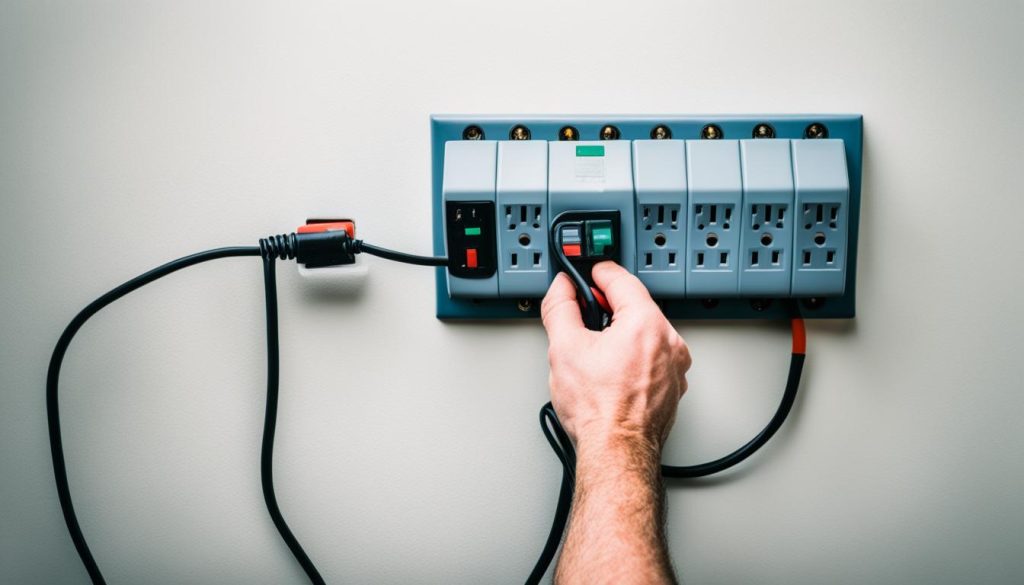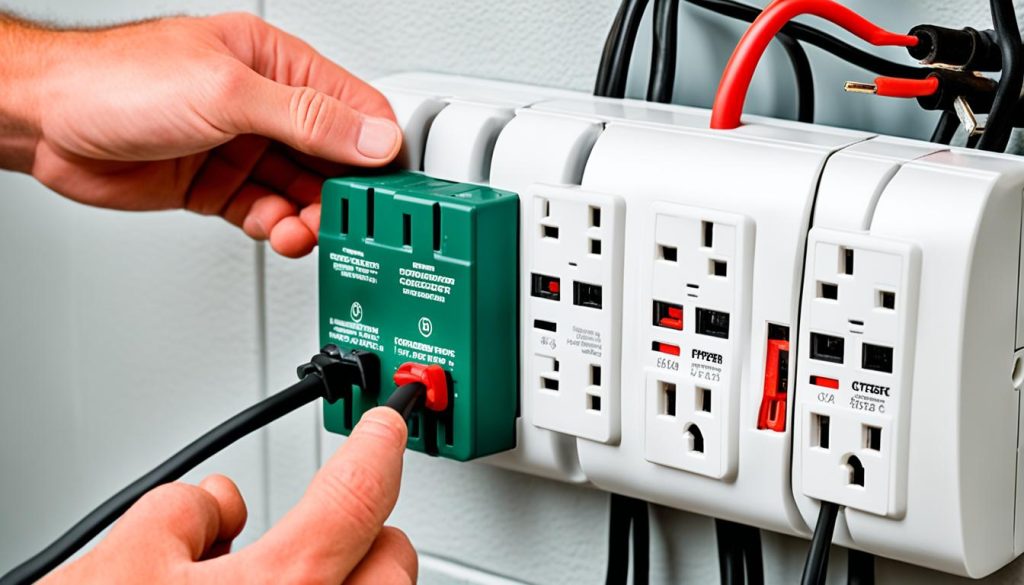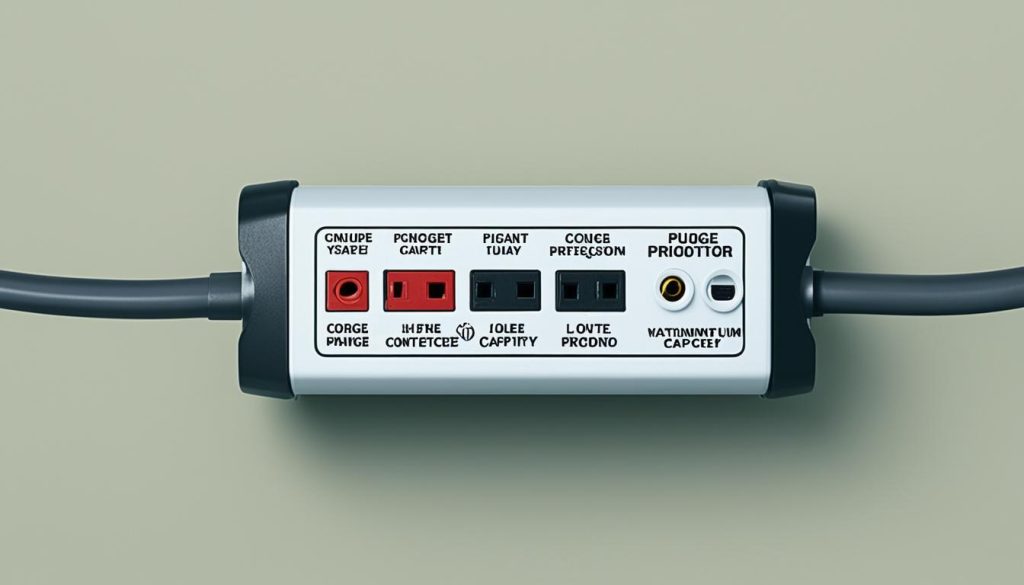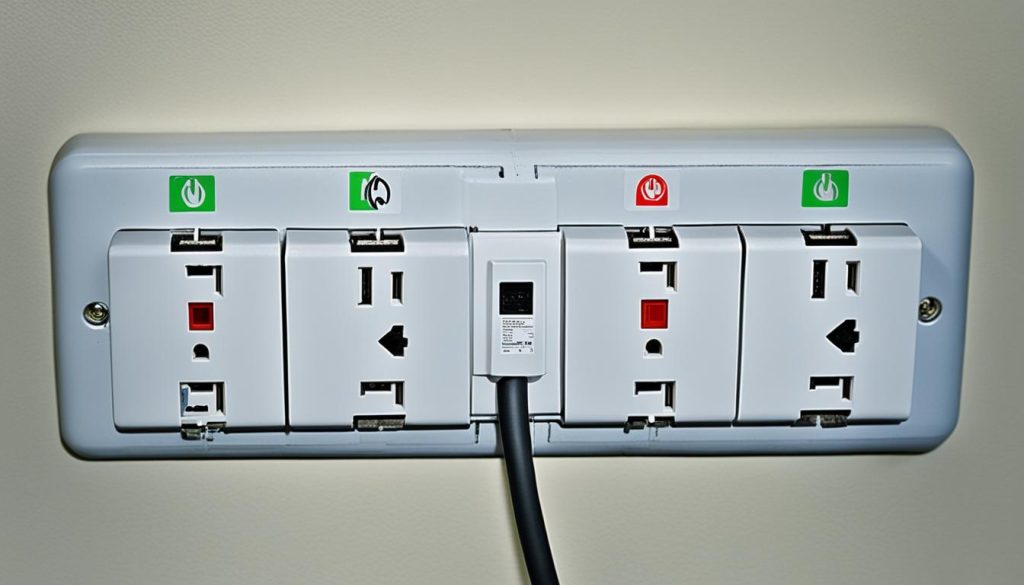When it comes to using surge protectors and extension cords together, safety should always be a top priority. Many people wonder if it’s safe to plug a surge protector into an extension cord, and the answer is not as straightforward as you might think.
While it is technically possible to connect a surge protector to an extension cord, experts do not recommend this practice due to safety concerns.
One of the main reasons is the mismatch in amp rating between the surge protector and the extension cord. Using an extension cord with a surge protector can increase the risk of fire and electrocution, especially if the gauge size of the surge protector and extension cord does not match. Mismatched amps can create a fire hazard, leading to potential accidents and damage.
Another important consideration is the use of high-wattage appliances. Plugging these devices into a surge protector connected to an extension cord can overload the circuit and pose a serious fire hazard. It’s best to avoid plugging high-wattage appliances into a surge protector altogether, but especially when it is connected to an extension cord.
Key Takeaways:
- Experts do not recommend plugging a surge protector into an extension cord due to safety concerns.
- The gauge size of the surge protector and extension cord should match to prevent fire hazards.
- Avoid plugging high-wattage appliances into a surge protector connected to an extension cord to prevent overloading and potential fires.
- Surge protectors and extension cords should be used as temporary or emergency solutions, not as long-term options.
- It is advisable to consult a qualified electrician for permanent, safer alternatives.
Surge Protectors and Extension Cords – Safety Considerations
When it comes to using a surge protector with an extension cord, there are important safety guidelines to consider. By following these guidelines, you can ensure the proper and safe usage of these electrical accessories.
One of the key considerations is matching the gauge size of the surge protector and extension cord. This is crucial because mismatched amp capacities can pose a significant fire hazard. Ensuring compatibility between the surge protector and extension cord will reduce the risk of electrical accidents and protect your property.
To further enhance safety, it is important to avoid plugging high-wattage appliances into a surge protector. Overloading a surge protector can lead to overheating and potential fire hazards. It is best to use surge protectors and extension cords as temporary or emergency solutions, rather than relying on them for long-term use.
For optimal safety and electrical performance, it is recommended to seek permanent alternatives from a qualified electrician. They can provide expert guidance on the proper installation of outlets and circuits, reducing the need for extension cords and surge protectors in the first place.
Best Practices for Using Surge Protectors with Extension Cords:
- Ensure the gauge size of the surge protector and extension cord match for compatible amp capacities.
- Avoid plugging high-wattage appliances into a surge protector to prevent overloading.
- Use surge protectors and extension cords as temporary or emergency solutions, not as long-term options.
- Consult a qualified electrician for permanent, safer alternatives to minimize risks.
By following these safety considerations and best practices, you can use surge protectors and extension cords effectively while prioritizing the wellbeing of your electrical system and property.
Power Strips, Surge Protectors, and Extension Cords
When it comes to providing additional outlets for your electronic devices, power strips, surge protectors, and extension cords play a crucial role. While it is possible to connect a surge protector to an extension cord or a power strip, it is important to understand the proper usage guidelines to ensure safety and optimal performance.
Surge Protector and Extension Cord Configuration
For a safe and effective setup, it is essential that the gauge size of the extension cord or power strip matches the surge protector. This compatibility ensures that the amps are properly regulated, reducing the risk of fire and other electrical hazards. Mismatched amps can create an imbalance and compromise the safety of your devices and your property.
Proper Use of Surge Protectors and Extension Cords
It is advisable to view surge protectors and extension cords as temporary or emergency solutions rather than long-term options. While they can provide temporary relief in situations where outlets are limited, seeking permanent, safer alternatives from a qualified electrician is recommended.
Using surge protectors and extension cords beyond their intended purpose can increase the risk of fires and electrical accidents. It is important to prioritize safety and minimize potential hazards.
When configuring your power setup, consider the following:
- Ensure the gauge size of the extension cord or power strip matches the surge protector.
- Avoid plugging high-wattage appliances into surge protectors to prevent overloading.
- Do not daisy-chain surge protectors and extension cords, as this can increase the risk of loose connections and electrical failure.
Remember, the goal is to protect your devices and property from electrical surges while ensuring your overall safety. Properly utilizing surge protectors, extension cords, and power strips will help you achieve this.

| Pros of Connecting Surge Protectors to Extension Cords | Cons of Connecting Surge Protectors to Extension Cords |
|---|---|
| Provides additional outlets for electronic devices | Increased risk of fire and electrocution |
| Can be used as a temporary or emergency setup | Mismatched amps can create a fire hazard |
| Offers protection against electrical surges | High-wattage appliances should not be plugged into surge protectors |
| Provides flexibility in power distribution | Permanent, safer options should be sought from a qualified electrician |
Understanding Power Strips and Surge Protectors
Power strips and surge protectors are two commonly used devices that provide additional outlets and safeguard against electrical surges respectively. It is vital to differentiate between regular power strips and surge protectors, as surge protectors offer added safety features to protect your valuable electronic devices.
When utilizing a surge protector with a power strip or an extension cord, it is crucial to follow proper usage guidelines to ensure maximum electrical safety. Here are some essential considerations:
- Gauge size matching: When connecting a surge protector to a power strip or an extension cord, it is essential to ensure that the gauge size of all the devices is compatible. Mismatched gauge sizes can increase the risk of fire and electrical hazards.
- Avoid high-wattage appliances: Plugging high-wattage appliances into a surge protector can overload the device and pose a potential fire hazard. It is best to connect these appliances directly to a power outlet.
- Temporary use: While power strips and surge protectors provide convenient solutions, they should be used as temporary or emergency measures, rather than long-term solutions. Seeking the assistance of a qualified electrician for permanent electrical installations is highly recommended.
To further illustrate the differences between power strips and surge protectors, refer to the table below:
| Power Strips | Surge Protectors |
|---|---|
| Provides additional outlets | Offers protection from power surges and spikes |
| Does not have built-in surge protection | Includes built-in surge protection to safeguard electronic devices |
| Typically less expensive | May be costlier due to added surge protection features |
Remember, when using power strips and surge protectors, always prioritize your safety by following usage guidelines and seeking professional help for permanent electrical solutions. Protecting your electronic devices and ensuring electrical safety should always be a top priority.

Extension Cords and Power Strip Safety
Extension cords are a convenient solution to extend the reach of power outlets when there is a shortage of available sockets. However, when using extension cords in conjunction with power strips or surge protectors, it is crucial to prioritize electrical safety to avoid potential hazards.
One important consideration is to ensure that the gauge size of the extension cord matches that of the power strip or surge protector. This ensures proper electrical performance and minimizes the risk of fire hazards.
It is advisable to use extension cords with low power demand appliances, such as lamps or phone chargers. Plugging high-wattage devices, such as space heaters or air conditioners, into extension cords can overload the cord and lead to overheating and potential fire risks.
It’s essential to note that extension cords should only be used as temporary solutions. If you find yourself relying on extension cords regularly, it is recommended to consult a qualified electrician to explore permanent electrical solutions for long-term safety and convenience.
| Extension Cord Safety Tips: |
|---|
| Match the gauge size of the extension cord with the power strip or surge protector. |
| Use extension cords with low power demand appliances. |
| Avoid plugging high-wattage devices into extension cords. |
| Consider consulting a qualified electrician for permanent electrical solutions. |
Expert Insight:
“Understanding the limitations and proper usage of extension cords is vital for maintaining a safe electrical environment. By matching the gauge size and avoiding overloading, you can greatly reduce the risk of fire hazards and ensure the longevity of your electrical devices.”
Surge Protectors and Extension Cords – Best Practices
When it comes to using surge protectors with extension cords, following usage guidelines and best practices is essential for ensuring optimal safety. Adhering to these guidelines will help prevent fire hazards and ensure the compatibility and proper use of surge protectors and extension cords.
The first step to using surge protectors and extension cords safely is to ensure that the gauge size of both devices matches. This compatibility is crucial as it helps prevent fire hazards caused by mismatched amps. When the gauge sizes of the surge protector and extension cord are not the same, it can lead to overheating and potentially cause fires. Matching the gauge sizes can help mitigate this risk.
Additionally, it is important to avoid overloading surge protectors by plugging high-wattage appliances into them. Surge protectors have specific wattage limits that should not be exceeded to prevent overloading and potential fire hazards. Plugging high-wattage devices into surge protectors can lead to overheating and even cause the surge protector to fail, rendering it ineffective in protecting against electrical surges.
It is also crucial to use surge protectors and extension cords as temporary or emergency solutions rather than as long-term options. Surge protectors and extension cords are not designed to be permanently connected to electronic devices or appliances. Instead, they should be used as temporary solutions until a qualified electrician can provide permanent, safer alternatives.
By following these best practices, you can ensure the safe and proper use of surge protectors and extension cords. Remember to match the gauge sizes, avoid overloading surge protectors with high-wattage devices, and seek permanent solutions from a qualified electrician. Prioritizing safety when using surge protectors and extension cords is crucial for protecting yourself, your property, and ensuring optimal electrical performance.

| Best Practices for Using Surge Protectors with Extension Cords |
|---|
| Match the gauge size of the surge protector and extension cord to prevent fire hazards. |
| Avoid plugging high-wattage appliances into surge protectors to prevent overloading and potential fire hazards. |
| Use surge protectors and extension cords as temporary or emergency solutions, seeking permanent options from a qualified electrician. |
The Risks of Daisy-Chaining Surge Protectors and Extension Cords
Daisy-chaining, or connecting multiple surge protectors or extension cords together, can pose significant risks to electrical safety. While it may seem convenient to extend the reach of power outlets, this practice can have serious consequences that compromise the well-being of your devices and increase the risk of fire hazards.
When you daisy-chain surge protectors or extension cords, you are lengthening the cord run and subsequently reducing the amount of electricity that can be effectively distributed to your devices. This can result in under-powering them, leading to potential malfunctions or damage.
The additional connections in the chain of surge protectors or extension cords can also become failure points and increase the risk of loose connections. Loose connections can cause electrical arcing, overheating, and potential fires. It is crucial to avoid daisy-chaining surge protectors and extension cords to ensure the proper electrical performance, minimize fire hazards, and safeguard the integrity of your devices.
“Daisy-chaining surge protectors and extension cords can compromise the electrical safety of your devices and increase the risk of fire hazards.”
Remember, safety should always be a top priority when it comes to electrical connections. Make sure to follow surge protector and extension cord usage guidelines to mitigate risks and protect your valuable electronics.

Here are some important guidelines to keep in mind:
- Do not daisy-chain surge protectors or extension cords.
- Use the appropriate gauge size of surge protectors and extension cords to match the electrical load.
- Avoid overloading surge protectors by plugging high-wattage appliances into them.
- Regularly inspect surge protectors and extension cords for any signs of wear or damage, and replace them if needed.
- Consider seeking the assistance of a qualified electrician to ensure proper surge protector and extension cord configuration for your specific needs.
By following these guidelines, you can ensure the optimal safety and performance of your electrical connections while protecting your devices from potential damage caused by daisy-chaining.
Safety Precautions and Recommendations
When it comes to using surge protectors and extension cords, safety should always be a top priority. Follow these precautions and recommendations to ensure a secure and reliable electrical setup.
First and foremost, avoid using extension cords with surge protectors for long-term or permanent solutions. While they can be convenient for temporary or emergency use, they are not designed to handle the continuous electrical load of appliances or devices over an extended period of time.
Additionally, it’s crucial to match the gauge size of the surge protector and extension cord. This helps prevent fire hazards and ensures proper electrical performance. Mismatched amps can lead to overheating and other dangerous situations, so double-check the compatibility before plugging your devices in.
For long-term electrical solutions, it’s best to consult a qualified electrician. They can assess your specific needs and provide permanent options that meet safety standards, minimizing the risk of accidents and property damage. Remember, investing in professional help ensures peace of mind and a reliable electrical setup.
FAQ
Can you plug a surge protector into an extension cord?
While it is technically possible to plug a surge protector into an extension cord, experts do not recommend this practice due to safety concerns. Using an extension cord with a surge protector can increase the risk of fire and electrocution.
What are the safety considerations when using surge protectors and extension cords?
When using surge protectors with extension cords, it is important to ensure that the gauge size of the surge protector and extension cord match, as mismatched amps can create a fire hazard. Avoid plugging high-wattage appliances into surge protectors to prevent overloading and potential fire hazards.
How do power strips, surge protectors, and extension cords differ?
Power strips, surge protectors, and extension cords all serve the purpose of providing additional outlets for electronic devices. While it is possible to connect a surge protector to an extension cord or a power strip, it is essential to follow proper usage guidelines to ensure electrical safety.
What should I know about using power strips and surge protectors?
When using a surge protector with a power strip or an extension cord, it is crucial to follow usage guidelines, such as matching the gauge size of the extension cord or power strip with the surge protector to ensure compatibility and reduce the risk of fire hazards.
Are there any safety considerations when using extension cords with power strips or surge protectors?
When using extension cords with power strips or surge protectors, it is important to prioritize safety. Matching the gauge size of the extension cord with the power strip or surge protector is essential for proper electrical performance and to reduce the risk of fire hazards.
What are the best practices for using surge protectors and extension cords?
Surge protectors and extension cords should be used as temporary or emergency solutions and not as long-term options. It is recommended to seek permanent, safer alternatives from a qualified electrician for optimal safety and electrical performance.
What are the risks of daisy-chaining surge protectors and extension cords?
Daisy-chaining, or connecting multiple surge protectors or extension cords together, can pose significant risks. It can decrease the amount of electricity that can be fed to devices, increase the risk of under-powering them, and create additional failure points and loose connections.
What safety precautions and recommendations should I follow when using surge protectors and extension cords?
To ensure safety, it is important to avoid using extension cords with surge protectors for long-term or permanent solutions. Match the gauge size of the surge protector and extension cord, and avoid overloading surge protectors by plugging high-wattage appliances into them. Seek the assistance of a qualified electrician for permanent electrical solutions.


